A BIRTHDAY SALUTE: Actor Lewis Wilson was born 104 years ago. Dig this INSIDE LOOK at Batman’s first time on celluloid…
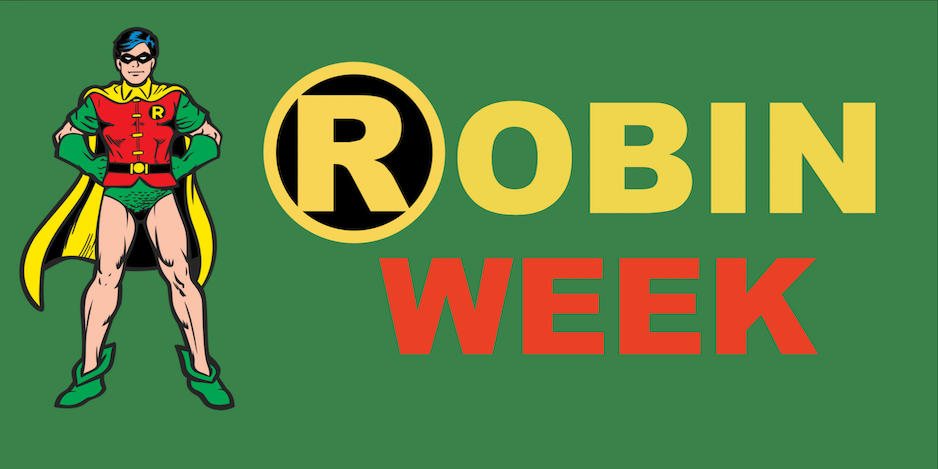
—
UPDATED: 1/28/24: The late actor Lewis Wilson — the first person to play Batman on screen — was born 104 years ago on Jan. 28, 1920. This piece first ran during 2020’s ROBIN WEEK, but it’s as relevant now as it was then. Dig it. — Dan
—
Welcome to ROBIN WEEK! One of the greatest heroes in comics history debuted 80 years ago this month — and we’re celebrating with a series of features saluting the Boys, Girls and Teens Wonder. For the complete index of features, click here.
—
It’s ROBIN WEEK, so it only made sense to take a look at the Boy Wonder’s first time on screen — which, of course, was Batman’s first time on screen, as well. Dig this look back at 1943’s Batman serial, by REEL RETRO CINEMA columnist Rob Kelly:

By ROB KELLY
DC Comics’ Dynamic Duo made their live-action debut in Columbia Pictures’ 15-chapter 1943 movie serial Batman, starring Lewis Wilson as Batman/Bruce Wayne, Douglas Croft as Robin/Dick Grayson, and J. Carrol Naish as the nefarious criminal mastermind Dr. Daka. Dr. Who? More on him in a minute.
As we have already covered in other movie serial-centric profiles for REEL RETRO CINEMA, movie studios barely seemed to care about the source material when translating comic book characters to live action. In Batman, our heroes are straight up officially sanctioned government agents who are on the lookout for Japanese saboteurs following the attack on Pearl Harbor.
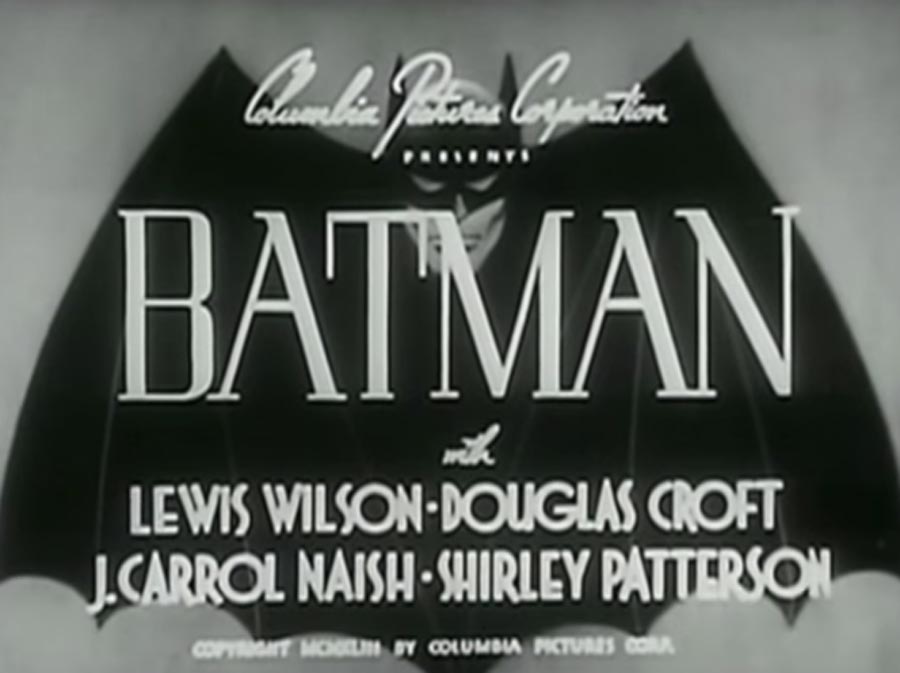
After Bruce Wayne’s girlfriend Linda (Shirley Patterson) tells Bruce that her uncle has been kidnapped, the investigation discovers it’s the work of Dr. Daka, who has a plan to steal Gotham City’s radium supply so he can use it to power his ray gun that can dissolve anything. Daka sends his goons to get the radium, and it’s up to Batman and Robin to stop them. But Daka (and the screenwriters) have come up with an interesting twist: accompanying the henchmen is a sort of zombie that Daka controls via an electronic brain implant!
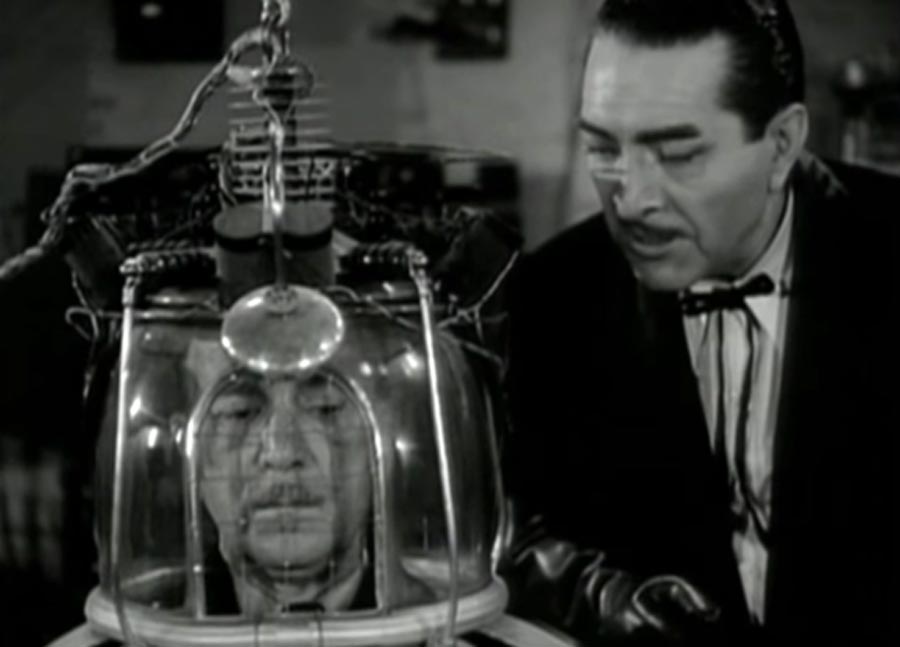
After Batman and Robin apprehend one of Daka’s goons, they oh-so-subtly suggest that the real live bats fluttering around “the Bat’s Cave” are hungry. The terrified goon gives up the secret that the radium has been taken to The House of the Open Door, located in the mostly-deserted Little Tokyo section of the city. This sets up the basic formula, where Daka’s goons show up to a location, Batman and Robin try and stop them, and then Daka comes up with a new plan. Lather, rinse, repeat.
Like what often happens with these serials, a comic book fan has to wade through endless fights with top-hatted goons and scenes of cars driving to and fro just to find bits and pieces that make this serial distinct from all the other Westerns, jungle adventures, and spy thrillers.
For instance, in Chapter One (“The Electrical Brain”), Batman delivers two crooks to the Gotham police, each thug festooned with black bats on their foreheads, a little piece of branding that the Ben Affleck Batman would use to slightly more gruesome effect. In this serial, Batman’s hideout is what he calls “the Bat’s Cave”, and shortly thereafter the comic book version would end up with such a place, arguably still the greatest superhero lair ever created.

Also influential was the serial’s take on Alfred, played here by William Austin (The Gay Divorcee, The Return of the Vampire). In the comics Alfred was always comically portly and slightly clumsy, but following the serial he would become tall, thin, and veddy veddy proper.
At a couple different points, Batman goes undercover (always welcome to this old school Bat-Fan), and Alfred gets included in a surprising amount of the action. There are one or two pretty cool death traps, like when in Chapter Fourteen (“The Executioner Strikes”), Batman barely escapes a room with knives sticking out from both walls. This drives Daka, frustrated at his foe’s ingenuity, to bellow, “Batman must be a magician or a devil!”
And that’s the real problem with Batman: its villain, Dr. Daka. Supposedly originally planned to be the Joker (Daka’s HQ is hidden inside a working funhouse), Daka is unfortunately written and portrayed as a World War II-era Asian stereotype, complete with derogatory references to his “yellow skin” and the shape of his eyes. When the narrator tells us that Little Tokyo is mostly deserted, it’s because “A wise government rounded up the shifty-eyed Japs.” Yuck.
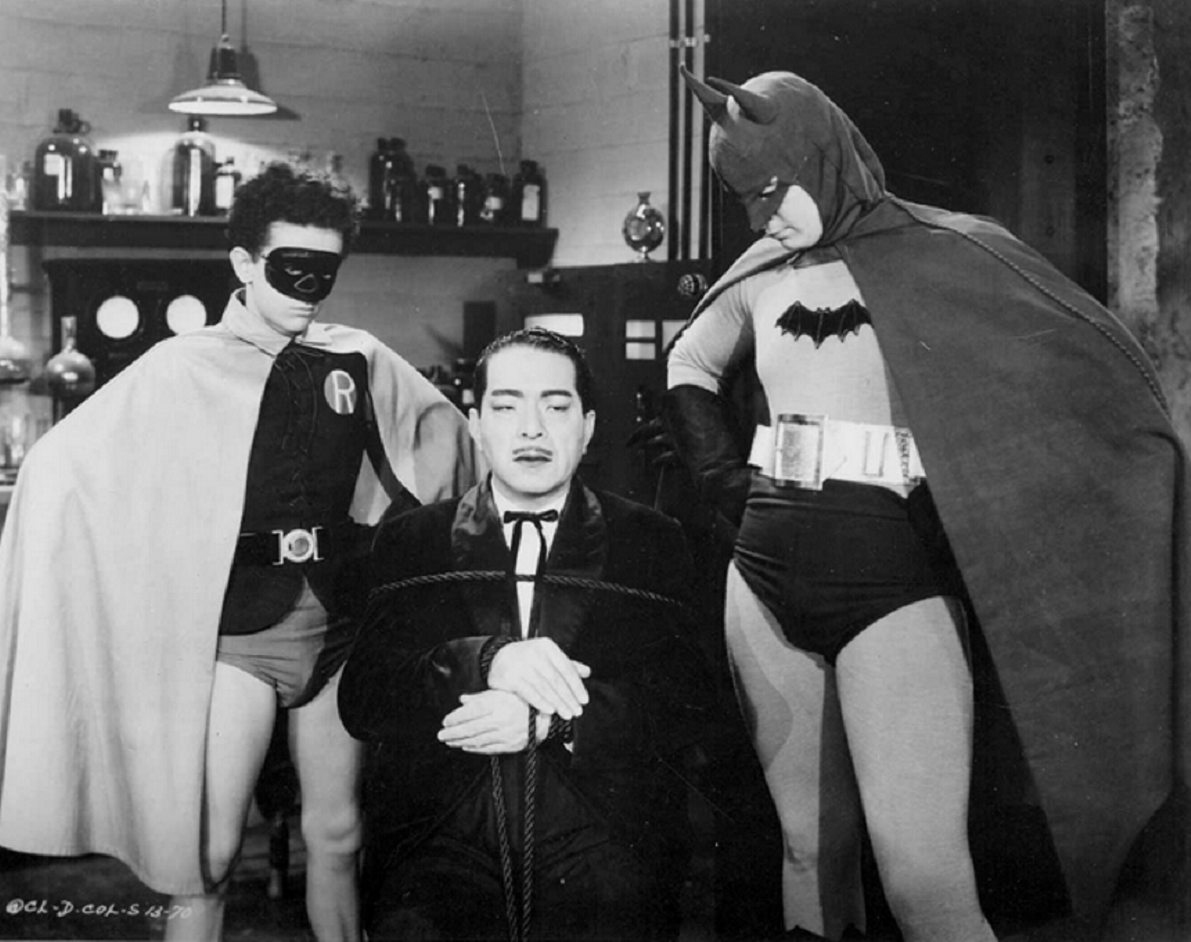
This new villain was specially created to appeal to American audience’s pro-war sentiments, and it’s unfortunate that instead of simply making the bad guy a spy or mad scientist, the filmmakers chose to wade into jingoism. Every scene that Naish — a gifted actor with a ton of credits like Beau Geste, Sahara and House of Frankenstein — is in just reminds you how unnecessary this change to the serial was. The mind reels as to what this thing might have looked like if it had been the Clown Prince of Crime as the main baddy. Inside his lair, Daka keeps a pit of hungry crocodiles, a very Joker-esque touch for sure.
If you can get past the ugly racism that litters this thing, the other performances are pretty solid. At 23, Lewis Wilson was the youngest screen Batman ever, but he looks older and has a nice swagger, especially in his scenes as Bruce Wayne.
Douglas Croft, as Robin, was only six years younger than Wilson, and they have a nice rapport. Robin doesn’t seem so much like a sidekick than a partner, trading jokes back and forth with a youthful joie de vivre that was always a hallmark of the character. After helping the Dynamic Duo beat up some goons, Linda’s uncle asks what happened to them all, to which Robin cheerfully replies, “We tossed them out the window!”

Costume-wise, yeah, our heroes both look pretty silly in their dime store Batman and Robin suits (Batman’s cape flops around in a less-than-atmospheric way), but the action scenes are generally pitched at such a speed that you don’t get a chance to get too bothered by it all.
As directed by Lambert Hillyer (who helmed a lot of Westerns but also some fun horror/sci-fi entries like The Invisible Ray and Dracula’s Daughter), Batman keeps moving at a brisk pace. And you always have to remember, these serials were meant to be watched a week at a time, where their repetitive sequences don’t get as, well, repetitive.
For whatever reason, when Columbia produced the second Batman serial, Batman and Robin, in 1949, none of the personnel, in front or behind the camera, was brought back to reprise their roles. (Click here for my REEL RETRO CINEMA column on that series.) Comparing the two serials, I think I’d give the edge to Wilson and Croft as Batman and Robin, while happily tossing Dr. Daka into a pit of crocodiles in favor of the 1949 serial’s villain the Wizard, not to mention the latter’s addition of Vicki Vale. So there’s something to be said for both efforts.
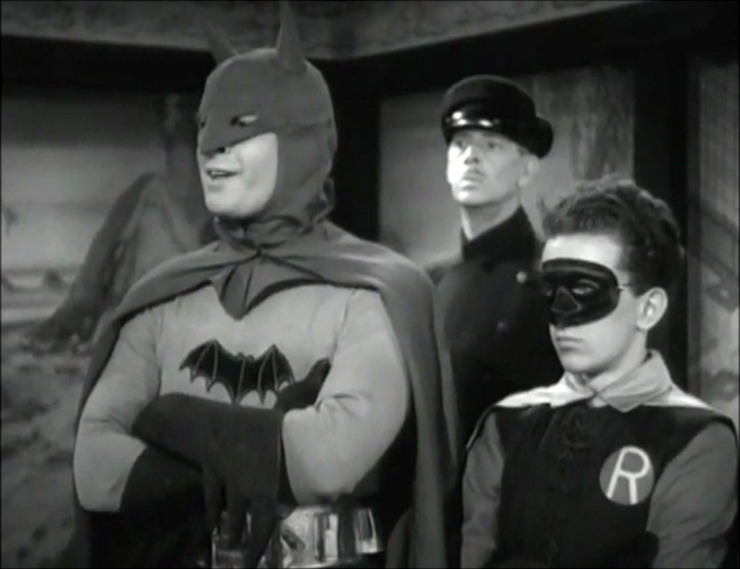
Batman was reissued in 1965 (helping inspire the pop culture explosion that was the TV show!) as one very long feature under the title An Evening with Batman and Robin, which sounds like something that would have been hosted by Dick Cavett. A heavily edited version was released on Super 8 (you could find it for sale in the back of a lot of Warren magazines), and then again on VHS and DVD.
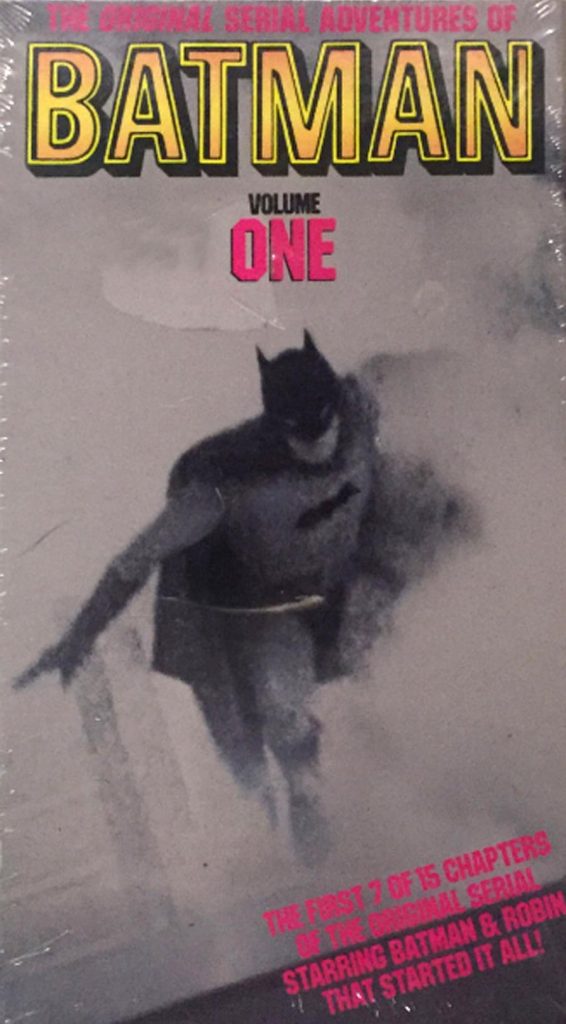
Back when I worked at a video store in the 1990s, we had this serial for rent, and I remember being charmed that the people who packaged it actually managed to find a still that made Batman look, well, kinda cool. Decidedly not cool is our very first glimpse of Batman in the movie proper, where he is sitting at his desk, looking like he’s having a major hissy fit.
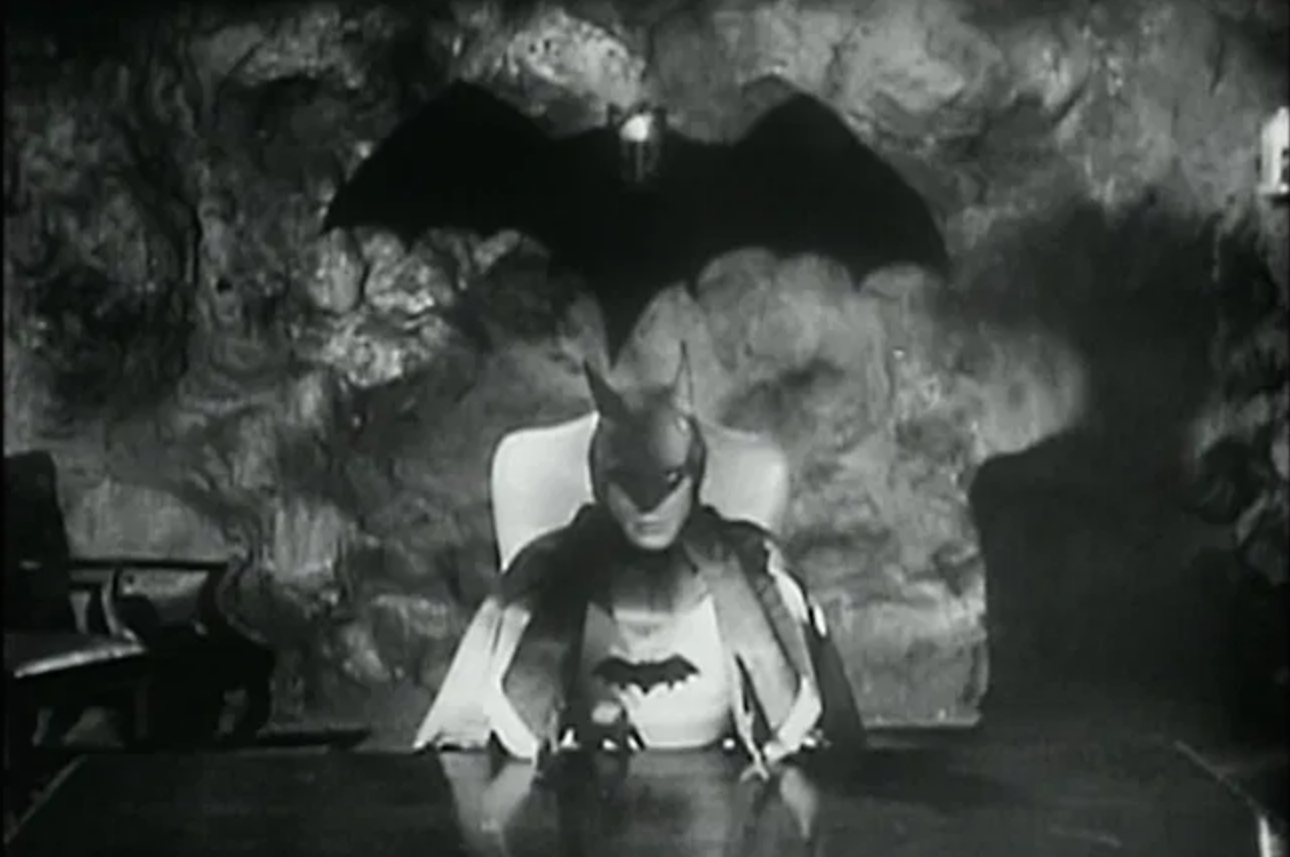
Like Batman and Robin, Atom Man vs. Superman and Captain America, the Batman movie serial is fun in places and certainly has its charms if you’re willing to sit through the three-hour plus running time. The Dr. Daka character is an unfortunate black mark on the production, but it’s still worth checking out, if only for the performances of Lewis Wilson and Douglas Croft, who will go down in the history books as the very first in a long—and ever-growing—line of live action Dynamic Duos.
—
MORE
— The ROBIN WEEK Index of Features. Click here.
— BURT WARD’s TOP 13 Moments as ROBIN. Click here.
—
Rob Kelly is a writer/artist/comics and film historian. He is the host or co-host of several shows on The Fire and Water Podcast Network, including Aquaman and Firestorm: The Fire and Water Podcast, The Film and Water Podcast, TreasuryCast, Superman Movie Minute and Pod Dylan.

March 9, 2020
I LOVE this serial. It’s one of the very first ones I saw (via the home miracle of silent 8mm Castle Films). Conversely, I hate the 1948 Batman serial. But it’s that way for me with a lot of serials (especially some of the Columbia ones) where they seemed to be much better done in the early 1940s, and more slapdash in the later 40s and early 50s.
Upon later reflection, nothing about this serial is particularly Batman-ish of the 1940s comics. It did contribute the Batcave, a revised version of Alfred, and Linda Page. Ironically, had those two actors been wearing the costumes of Captain America and Bucky, this would have seemed like a story straight out of a 1942-43 issue of CAPTAIN AMERICA COMICS.
March 9, 2020
Absolutely my favorite live action version of Batman– very pulp-ish with the zombies, death traps, alligators and a creepy hide-out for Daka. I think people who are stuck on the racist aspects of the serial don’t keep it in context– the Japanese had attacked America nearly the very moment their diplomats were discussing a peace in Washington– the very definition of a sneak attack. Propaganda was instrumental in winning World War II. Daka’s portrayal is nowhere near as extreme as some of the Bugs Bunny cartoons of the time handled Japanese. It’s easy to arm chair quarterback political decisions of the time.
And it wasn’t Linda’s uncle who asked about the missing bad guys, it was Alfred in disguise.
March 9, 2020
I admit I’ve never seen any of these, at least not that I remember. I look forward to seeing them though and hope I can get them in a DVD set. But that costume is even less scary than the Adam West version. The ears are funny looking enough, but the waistline on the briefs are higher than my Uncle Fred’s pants or SNL’s Ed Grimley’s (Martin Short) rib cage high pants.
March 9, 2020
I’ve never seen these 1940s “Batman” serials before. I think I’ll give them a shot.
March 9, 2020
I’ve LOVED this serial since the first time I saw it.
If I have any major criticism, it would be the same as many other such serials… it’s ONE big story that goes on too long. I’d have much rather if they’d done a series of “B” movies, each one with the same cast, but different villains. There’s too many places where the story should have ended, either because the villains figured out who Batman was, or Batman figured out WHERE the baddies’ HQ was.
On the up side… I maintain this one film is the single MOST authentic depiction on film of the personalities of Bruce Wayne, Dick Grayson and Alfred from the early comics ever seen on film. Bruce’s girlfriend Linda, who barely appeared in the comics at all, was also portrayed quite well.
And what can I say about J. Carrol Naish as the criminal spy-boss, “Dr. Daka”? He’s a riot! A low-rent “Dr. Fu Manchu” who used technology to turn victims into mindless zombie slaves, who heads a sabotage gang, has an underground hideout (gee, just like Batman), and keeps pet alligators in the basement. One of the cliffhangers, a pair of SPIKED walls closing in, was borrowed for Julie Newmar’s debut story on the TV series.
The ONE thing really missing, and this baffles me… is Commissioner Gordon!! Gordon appeared in the very 1st “BATMAN” comic story, and after spending a few years following and admiring the exploits of the mysterious vigilante, came forward and OFFICIALLY deputized him as a member of the Gotham City Police Department– shortly BEFORE this film was made. So WHY is he not here, WHY is Batman still portrayed as a “vigilante” in the eyes of the cops, and WHY did they have some ARROGANT Chief of Police who wanted to ARREST Batman, so he could unmask him– and then FORCE him to continue fighting crime, FOR HIM?? (One simply cannot imagine O’Hara behaving this way– heh.)
And, ironically, in this story, Batman’s true identity is KNOWN to a member of the F.B.I.– who recruits Batman to fight the spy ring. Shades of “Simon Templar” (THE SAINT) !
March 10, 2020
In talking with the 2nd Robin (John Duncan) in the 90s at a collectors show in N. Hollywood he commented on Robert Lowery (Batman). He was not in great physical shape. In fact had to be strapped in a girdle to fit his Batman costume.
In scenes where he ran he would run out of gas quickly. Lewis Wilson much younger when he played Batman at 23. He had also been a competitive swimmer so he he as in better physical shape. No doubt the costumes each wore were not that attractive. Again one does have to consider the materials of the day and the budgets of serials produced by Columbia. Plus serials target audiences—-kids at Saturday matinees! Final note on Robin to my knowledge Douglas Croft has been the only movie Robin to be portrayed by an actor close in age to the original comic book Robin.
March 10, 2020
When I first saw “BATMAN AND ROBIN” (1949), I was severely disappointed. The recasting of Bruce, Dick AND Alfred were all major steps down. Also, I don’t particularly care for it when 15-chapter-long serials have “mystery” villains whose true identities they don’t reveal until the last 2 minutes of chapter 15 (by which point, you’ve long since stopped caring). Knowing the villain up-front was one of the reasons I liked “BATMAN” (1943) and “CAPTAIN AMERICA” (1944) so much.
Then there was the Gardner Fox / JLA style “fantasy sci-fi” machine of The Wizard, which made ZERO sense. Fox’s “JLA” in the 60s was often like that– entire stories based on concepts that could not possibly be explained by any kind of science, real or imagined! You were forced to just put yourself in the right frame of mind, for them to work at all.
The high points of the ’49 serial were Vicki Vale (I understand the character in the comic was based on the one in the movie!), and, Lyle Talbot’s Commissioner Gordon, in my view, the MOST authentic portrayal of Gordon ever seen on film.
On the other hand, I got a laugh seeing this older Robin drive like a maniac. I realized at once, HE was the guy the version seen in the Joel Schumacher movies was based on.
Back to 1943… having read tons of the earliest Bat-comics again in recent years, I appreciated how Bruce & Dick were not portayed as adoptive father and son, but more as adoptive older and younger BROTHERS. And Batman & Robin were PARTNERS, not hero & sidekick. I particularly got a laugh when Dick nagged Bruce about his “boring weakling” persona, taken straight from Don Diego Vega in “THE MARK OF ZORRO”. Dick said, “You better watch that, or one of these days you’ll take it too far.”
I’ll say it– I wish the Adam West & Burt Ward versions of Bruce & Dick had been more like this!
Finally, I loved how the 1943 Alfred was portrayed as a “nervous Nellie” who strove to overcome his own fears, in order to be part of the team. GO, Alfred! I can easily imagine Alan Napier’s Alfred being the same guy, with many years of experience behind him allowing him to deal with danger & adversity without batting an eye. Especially when he got into a fencing match with Cesar Romero… heh.
March 10, 2020
I’ve gone back and forth over the years on which of the serials I prefer. Despite Dr. Daka (who Roy Thomas brought into Earth-Two continuity in All-Star Squadron), I think this one does feel more “Batman-esque”. There’s a bit of the mood of the comics in it here and there, and Batman’s mask years don’t stick straight out to the side like Lowery’s did. Not sure about those high-waisted trunks, but hey.
Great article, Rob!
December 26, 2020
I’m indebted to the ’43 serial; which I saw at the kids’ Saturday matinee in UK in 1963 when I was 7yo. I thought it was the best thing I’d ever seen! I’d never heard of Batman – or any other long underwear character – and this serial: poor though it was – was responsible for starting a lifelong love of Superhero Comic Books!
For years after, if a B&W Columbia Film was on TV: when the logo came on screen (of the statue that is very nearly Liberty – but not quite) the hairs on the back of my neck would stand on end with remembered excitement!
So it was a pleasure to read your excellent article! It was reassuring to find that I’m not the only one who is aware of the Cinematic masterpiece – if I mention it to most people in UK I just get a blank look! (Which I don’t need as I already have one of my own!)
January 28, 2022
Both serials are just plain fun. I had always wondered a few things. No one in the Columbia costume department, could not be slightly more “imaginative” in the costume designs!. And how about slapping a paper mache Bat face on the front of their car. Bob Kane saw them filming the first serial on the lot and was surprised there was no Batmobile. The first serial needs major restoration, and thanks to the anti Japanese material, will most likely never get it.
January 30, 2021
During the early Batman craze in the mid 60’s, my local theater showed this serial on two Saturday mornings. Chapters 1-8 the first week, 9-15 the next. Of course I made the walk both weeks!
January 31, 2021
Policeman pulls Batman over to the side of the road and says, “Batman, does Bruce Wayne know you’re driving his car?”
Classic.
January 31, 2021
That was Vicki Vale!
January 29, 2022
I disagree with your comments on Doctor Daka. The American People were at war with the Japanese war machine just as we were with the Nazis of Germany. Plus, this was basically propaganda for our side pure and simple written in a very basic manner. There was no room for deep dives on “how’s” and “whys” here. We need, in such cases, to take into the “time” and “place” for such entertainment. We, with the separations of time and healing, to let it be what it is and move on…
January 30, 2022
Agree. America had been dragged into a World War, families were losing their fathers. People understandably viewed the Japanese of that era as being just as much the enemy as Nazis. in the midst of this horrific scenario both the Nazis and the Japanese made excellent villains and the use of stereotyping helped provide some catharsis to an audience that surely wanted to see our heroes triumph over a very real enemy (and I’m sure most modern Japanese would completely understand this). Our current tendency to view history through a distorted prism where we are always trying to find fault with our own culture is exactly the reason it is so important for this material to still be available…it is a window through which we can gain a greater appreciation of how people who actually lived through those times really felt. That said, I enjoyed the article and plan to re-watch this again as a result.
August 23, 2025
I can sort of live with Daka (if only because Naish is a lot of fun), but the line from the narrator about the internment of Japanese-American citizens is pretty revolting.
January 29, 2022
One minor correction on the “An Evening with Batman and Robin” campaign during the 60s to cash in on the TV Batman fame.
If you look at the posters (I have a large original at my home) There are no cast credits and other than the tag line “Made in 43 and discovered in 65” It gives no indication which serial is playing. In fact I went to the theater and saw Batman and Robin from 1949..which I consider the longer lasting for todays audience. It is my understanding Columbia sent both serials out and it depended on which theater you attended which version you saw.
The combination of Robert Lowery, who played a lighter Batman, more similar in nature to the then current TV show. and John Duncan worked best. Because it is not a war period story, The Wizard with his science fiction gizmos are ageless.. thought the hardware may not be.
Columbia made a pile of money on it as there was little if any financial outlay on their part. They did not even haveto edit the serial to a feature length. Just design a new poster. National Screen took care of the printing an distribution of the posters, so no cost there.
It was a smart move and introduced some youngsters to serials.
https://i.pinimg.com/564x/a0/54/e0/a054e0b1e96f86be5c1ed58faf79935c.jpg
January 28, 2024
I first encountered this series on the super eight reel to reel that my father checked out from the library. There wasn’t any sound and only chapters 5 and six were available but I was still blown away.
May 11, 2024
I hope we eventually get Blu-ray releases of the 1943 and 1949 Batman serials.